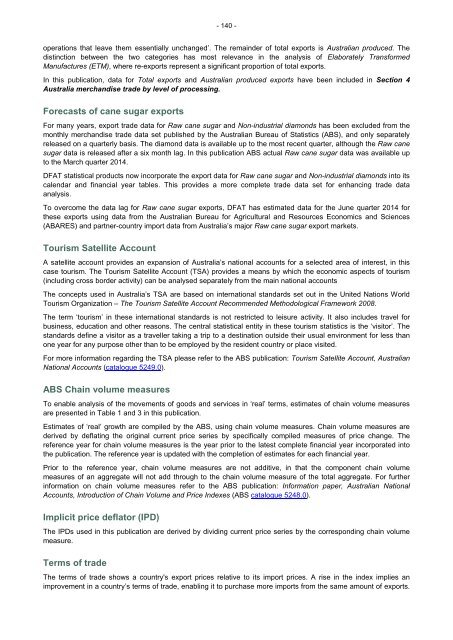cot-fy-2013-14
cot-fy-2013-14
cot-fy-2013-14
Create successful ePaper yourself
Turn your PDF publications into a flip-book with our unique Google optimized e-Paper software.
- <strong>14</strong>0 -<br />
operations that leave them essentially unchanged’. The remainder of total exports is Australian produced. The<br />
distinction between the two categories has most relevance in the analysis of Elaborately Transformed<br />
Manufactures (ETM), where re-exports represent a significant proportion of total exports.<br />
In this publication, data for Total exports and Australian produced exports have been included in Section 4<br />
Australia merchandise trade by level of processing.<br />
Forecasts of cane sugar exports<br />
For many years, export trade data for Raw cane sugar and Non-industrial diamonds has been excluded from the<br />
monthly merchandise trade data set published by the Australian Bureau of Statistics (ABS), and only separately<br />
released on a quarterly basis. The diamond data is available up to the most recent quarter, although the Raw cane<br />
sugar data is released after a six month lag. In this publication ABS actual Raw cane sugar data was available up<br />
to the March quarter 20<strong>14</strong>.<br />
DFAT statistical products now incorporate the export data for Raw cane sugar and Non-industrial diamonds into its<br />
calendar and financial year tables. This provides a more complete trade data set for enhancing trade data<br />
analysis.<br />
To overcome the data lag for Raw cane sugar exports, DFAT has estimated data for the June quarter 20<strong>14</strong> for<br />
these exports using data from the Australian Bureau for Agricultural and Resources Economics and Sciences<br />
(ABARES) and partner-country import data from Australia’s major Raw cane sugar export markets.<br />
Tourism Satellite Account<br />
A satellite account provides an expansion of Australia’s national accounts for a selected area of interest, in this<br />
case tourism. The Tourism Satellite Account (TSA) provides a means by which the economic aspects of tourism<br />
(including cross border activity) can be analysed separately from the main national accounts<br />
The concepts used in Australia’s TSA are based on international standards set out in the United Nations World<br />
Tourism Organization – The Tourism Satellite Account Recommended Methodological Framework 2008.<br />
The term ‘tourism’ in these international standards is not restricted to leisure activity. It also includes travel for<br />
business, education and other reasons. The central statistical entity in these tourism statistics is the ‘visitor’. The<br />
standards define a visitor as a traveller taking a trip to a destination outside their usual environment for less than<br />
one year for any purpose other than to be employed by the resident country or place visited.<br />
For more information regarding the TSA please refer to the ABS publication: Tourism Satellite Account, Australian<br />
National Accounts (catalogue 5249.0).<br />
ABS Chain volume measures<br />
To enable analysis of the movements of goods and services in ‘real’ terms, estimates of chain volume measures<br />
are presented in Table 1 and 3 in this publication.<br />
Estimates of ‘real’ growth are compiled by the ABS, using chain volume measures. Chain volume measures are<br />
derived by deflating the original current price series by specifically compiled measures of price change. The<br />
reference year for chain volume measures is the year prior to the latest complete financial year incorporated into<br />
the publication. The reference year is updated with the completion of estimates for each financial year.<br />
Prior to the reference year, chain volume measures are not additive, in that the component chain volume<br />
measures of an aggregate will not add through to the chain volume measure of the total aggregate. For further<br />
information on chain volume measures refer to the ABS publication: Information paper, Australian National<br />
Accounts, Introduction of Chain Volume and Price Indexes (ABS catalogue 5248.0).<br />
Implicit price deflator (IPD)<br />
The IPDs used in this publication are derived by dividing current price series by the corresponding chain volume<br />
measure.<br />
Terms of trade<br />
The terms of trade shows a country's export prices relative to its import prices. A rise in the index implies an<br />
improvement in a country’s terms of trade, enabling it to purchase more imports from the same amount of exports.


